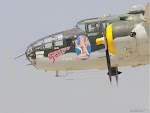- A Bit of History
- Advantages of Paper Modeling
- Basic Tools
- Sites with Free Paper Models
- www.papermoders.com Forum
- tutorials
I started building plastic scale models as a grade-schooler. In high school, I build my first model railroad (HO scale) and began scratch building in wood. Around the year 2000, I discovered paper scale models and I haven't looked back.
A Bit of History
Paper models have been around since the early 1800s when they were first printed in Europe, and they remain very popular today among European scale modelers.
In Eastern Europe during the Soviet era, there were no plastic model kits. Paper and wood were the only media available to most modelers behind the Iron Curtain. Publishers in Russia, Poland, Czechoslovakia, and East Germany produced printed paper kits for that market, but the paper and inks were usually of poor quality.
After 1989, those publishers gained access to better papers, better inks, and western markets. Today, several companies continue to produce high-quality printed kits for a worldwide market.
Today the Internet has created a wider paper model industry. Using dedicated software, almost anyone can create a scale paper model kit and upload it to the Web for sale through "e-stores" or free distribution through portal sites. Dozens of new kits come online every week, many of them free or priced very low.
The huge variety of paper models offers something for everyone. The basic skills of paper modeling are easy to learn. And finished paper models are often mistaken for plastic models. As the prices of plastic models continue to rise, affordable paper models are gaining popularity.
Advantages of Paper Modeling
- Low-cost & Free Kits
- Simple Tools & Techniques
- No Paints or Decals Needed
- Huge Variety of Subjects & Scale
- The Glue Tastes Better
Basic Tools
- Sharp scissors - hobby knife - steel straight-edge - toothpicks (for applying glue) - straight pin or T-pin (for scoring folds) - colored markers or pencils to color cut edges
- Materials (from any craft shop)
- 60# to 70# cardstock for printing downloaded kits -- My favorite is Wausau Bright White or Neenah Bright White Premium Cardstock, 65#, from Staples or Office Max.
- Heavier card, about 1 mm thick for formers, wing spars, etc. - Cereal boxes are about 0.5mm thick; the backs of writing pads are about 1mm.
- 0.010" to 0.020" piano wire for masts, struts, and landing gear
- Aleene's Tacky Glue - a water-based white glue with less water content than Elmer's Glue.
- Weldbond white glue for bonding plastic canopies and wire parts to paper
- Avery Permanent Glue Stick for laminating parts
- Watercolor pencils for coloring cut edges of paper parts -- You don't need to match the color; an assortment greys and black works well.
These Sites Offer Free Paper Models to Get You Started
- E-Cardmodels -- click on "Free Models" - Kits are rated in difficulty from 1 to 5.
- Currell Paper Models -- his V-1, V-2, & Airships are nice free models with excellent instruction sheets
- Papermau - a portal site for hundreds of free paper models from very simple to fairly complex
- Space Station 42 -- a portal site for free paper models of various kinds and difficulty
- Lower Hudson Valley Paper Models E-Gift Shop --free SciFi and real space models
- Paper Shipwright -- ships, lighthouses, and harbor buildings, including lots of free downloads
- Or just Google "free paper models"
www.papermodelers.com
is an online forum of friendly and mutually supportive paper modelers. You'll find help for every level of paper modeling and some very skilled modelers and designers. And there is a huge archive of free downloadable models. If you are a paper modeler and you are not a member of papermodelers.com, slap yourself, then go join.



No comments:
Post a Comment